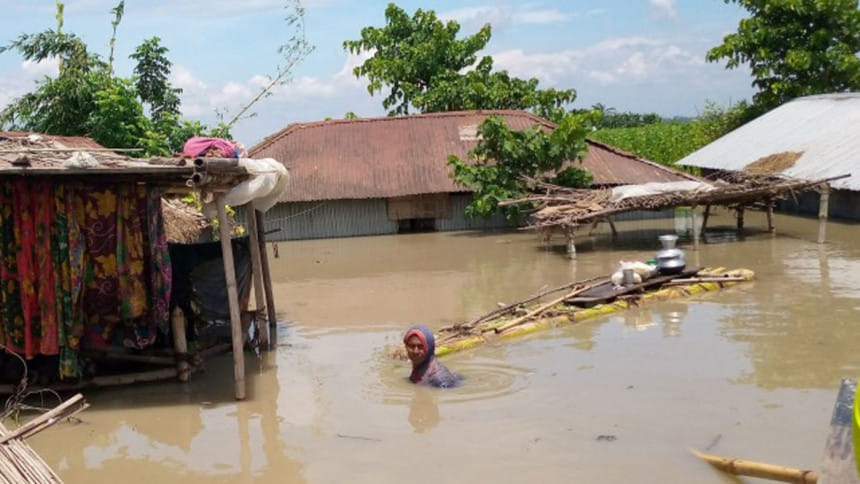Unpredictable disaster risks overlapping with Covid-19 and poverty in Kurigram

According to data from the Household Income and Expenditure Survey (HIES) 2016, which was reported on in 2019, the poverty levels have been sky high in Kurigram over the last ten years. Earlier this year, a report from The Business Standard said that Kurigram's poverty level was 70.8 percent. The district is densely populated, with a total of 17,25,509 poverty-stricken people.
A trip to Kurigram this year reminded me of the Bhatiyali songs of Abbasuddin Ahmed. These songs by the revered folk singer were an outcome of the many journeys he made on the rivers of North Bengal. At the time, Kurigram was recognised for its economic activities, much of which were done through its river ports, particularly Chilmari.
During my visit, while crossing the Dharla and Teesta river, I noticed that the river bed was visible and the water reservoir was not working, showing the dire need for dredging—the lack of which has led to continuous floods in the poverty stricken Kurigram district. Upon reaching Chilmari, I hopped on a boat on the Jamuna River and headed towards the islands (chars) where Friendship runs its many projects. The journey is amazing, and the islands in the distance are truly a wonderful sight. However, once you reach the islands, you realise that each of them are major crisis zones in reality.
In the wake of Covid-19, due to increased health hazards as well as floods, the people in the chars had their mobility severely restricted. In fact, the flood situation worsened to such an extent in mid-July that the Brahmaputra, Dharla and Dudhkumar rivers were flowing above the danger level, leading to a scarcity of basic amenities for those living in poverty. According to a report by The Daily Star from mid-July, "more than three lakh flood-affected people in 400 villages of 56 unions in nine upazilas are living in misery as they face an acute shortage of food, pure water and toilet facilities."
As a result, people in the chars couldn't find work—60 to 70 percent of these people are day labourers; very few are land owners. None of these workers could tend to crops or go fishing due to the rising water levels. I learned that around March and April, they went into lockdown and the markets were also no longer accessible. With their mobility restricted, whatever savings they had were exhausted. While they were struggling to earn a living due to the pandemic, natural disasters like floods continued to add to their miseries—char dwellers lost their assets and were forced to take loans at the same time. Livestock such as cows, goats, ducks and chickens are to low-income families what fixed deposits are to us urban dwellers—selling them off is no simple decision to take. Additionally, their loans are also mostly taken from unregistered money lenders who charge the borrowers a 100 to 200 percent interest rate.
When flood waters are rising, a lot of char dwellers stay back to protect their livestock—even if they are neck or waist-deep in water, they build raised platforms in their homes to stay protected. Why do they do it? For the simple fact that the cow or the goat is a crucial resource for their families. Finding a shelter that will also protect their livestock is not always possible. In these trying times, Friendship had built some raised plains that can house 20-25 homes, as well as 100-200 families. It's an environment friendly intervention, where a lot of people gather. Some people also seek shelter in the local schools, whereas others take refuge in the embankments. The challenge, however, lies in moving with livestock—a big boat is necessary for this, which is often too expensive.
There are a few measures that can be taken by NGOs and INGOs to eliminate the risks associated with floods in low-lying lands in Kurigram. The first thing that can be done is funding the boat fares—paying Tk 500 to boatsmen could easily be done by the government or NGO run local initiatives operating there. Funding the rescues and shift to shelters is a better option than just providing them with relief. Other problems include staying at home to look after the elderly or the sick. As a result, they are cut off from access to medication and other essentials. If a boat can deliver these basic resources, this could drastically bring down the likelihoods of disease. The government livestock department's vaccination team could also provide services that will benefit them in managing their assets.
The sudden arrival of Covid-19 has also brought a stop to educational activities for almost six to seven months now, resulting in school dropouts of the children living in the fringes of Kurigram. A report from The Daily Star this month said that erosion by the Brahmaputra, Dharla and Teesta rivers have resulted in the collapse of at least 10 government primary schools in different char areas under four upazilas of Kurigram. Additionally, the health burden of Covid-19 and waterborne diseases also keep children away from school. The absence of education leads to children exploring employment opportunities with their families. If their parents are doing agricultural labour such as fishing, the child is most likely to follow suit with the hopes of bringing in greater income for the household. As a result, the engagement with economic opportunities becomes so dominant for the child that there is little scope of returning to education.
In the absence of proper income, television and internet access and affordability is not something that is present in these areas, thus depriving children of the remote education that is available countrywide. Simply put, they are now victims of a long-term crisis—there is no saying how many adults will gain back their access to job markets and how many children will return to school. Many of them have incurred asset losses and are also burdened with loans. For the children who are missing out on education, there is likely to be a major gap in their learning process that will impede their progress.
Despite living in a country that is experiencing technological advancements, these marginalised communities are lagging behind. What is evident in North Bengal is that poverty and natural disasters, coupled with Covid-19, has increased their struggles tenfold. While the disease burden has increased, other things that are expected to rise are the population, as well as malnutrition. Since mortality and morbidity always puts the economy under pressure and reduces working capacity, the strengths and abilities of workers are compromised in the wake of a widespread disease. The inability to afford treatment further exacerbates the problem, which contributes to loss of motivation to work, which in turn hinders their skills from growing. What is needed is interventions that target communities, areas and families. Simply providing relief or funding alone will not solve the problem.
A way forward for Kurigram would be the inclusion of context specific interventions as well as an enabling environment where children can go back to school. In addition to that, some region specific designs need to be tailored in order to provide free services, such as free boats for transportation as well as shipping, in order to increase market accessibility for workers living in the fringes. Other services that can be introduced to them would be interest free loans. Moreover, there's an immediate need to address the losses these people have incurred so that we can design a comprehensive solution that mitigates the problems arising from poverty, Covid-19 and natural disasters such as floods and cyclones.
Kazi Amdadul Hoque is an environmental and social activist, and director of strategic planning and head of climate action in Friendship. Email: [email protected]

 For all latest news, follow The Daily Star's Google News channel.
For all latest news, follow The Daily Star's Google News channel. 



Comments